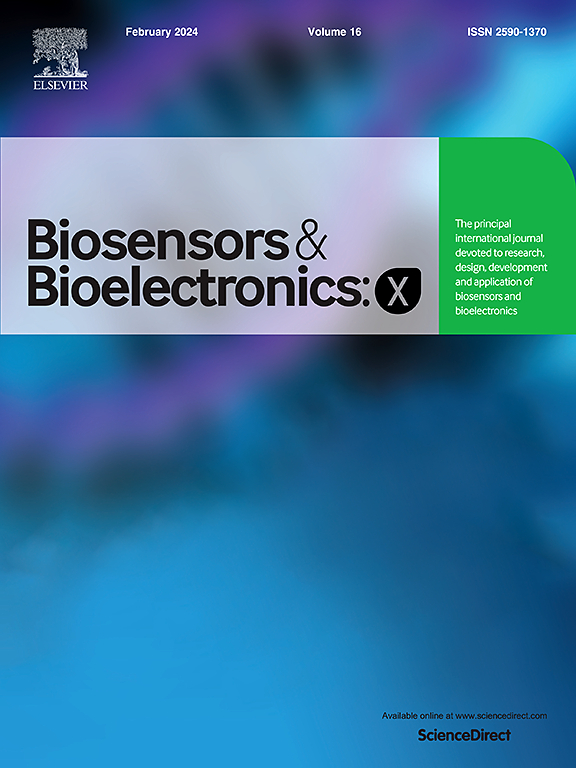使用荧光量子点探针和化学计量模型在单一底物上同时检测人中性粒细胞弹性蛋白酶和组织蛋白酶G
IF 10.61
Q3 Biochemistry, Genetics and Molecular Biology
引用次数: 0
摘要
人中性粒细胞弹性酶(HNE)和组织蛋白酶G (CatG)是参与慢性创伤病理生理的关键蛋白水解酶。这些酶的高水平表明炎症延长和愈合过程受损,因此对它们的区分和量化对于有效的伤口管理和治疗策略至关重要。在这项研究中,我们提出了一种新的方法,将不同尺寸的CdTe量子点(QDs)作为荧光探针,利用化学计量学分析实现HNE和CatG的同时识别和定量平台。采用动力学和激发/发射矩阵(EEM)两种不同的方法获得荧光响应。这些二阶数据使用各种化学计量模型进行处理,包括未展开的偏最小二乘残差双线性化(U-PLS/RBL)、径向基函数人工神经网络(RBF-ANN)和偏最小二乘判别分析(PLS-DA),以确保详细和精确的分析。结果表明,用上述模型处理后,动力学方法可以准确地量化HNE存在下的CatG, REP约为20%。该方法也成功地对两种酶进行了共同和单独的鉴别,灵敏度和特异度均为1。相比之下,EEM方法只允许两种酶一起和单独区分。我们开创性的方法被证明对其中一种酶的鉴别和定量都是准确的,提供了比其他参考程序更简单和更快的优势。该方法为更有效的治疗干预铺平了道路,并可能开启同时识别多种酶的途径。本文章由计算机程序翻译,如有差异,请以英文原文为准。

Simultaneous detection of human neutrophil elastase and cathepsin G on a single substrate using a fluorometric quantum dots probe and chemometric models
Human neutrophil elastase (HNE) and cathepsin G (CatG) are crucial proteolytic enzymes involved in the pathophysiology of chronic wounds. High levels of these enzymes indicate prolonged inflammation and impaired healing processes, making their discrimination and quantification essential for effective wound management and treatment strategies. In this study, we propose a novel method combining distinctly sized CdTe quantum dots (QDs) as a fluorescent probe to implement a platform for simultaneous discrimination and quantification of HNE and CatG, applying chemometric analysis.
The fluorometric response was acquired using two different methods: kinetic and excitation/emission matrices (EEM). These second-order data were processed using various chemometric models, including unfolded partial least-squares with residual bilinearization (U-PLS/RBL), radial basis function artificial neural network (RBF-ANN), and partial least squares-discriminant analysis (PLS-DA), to guarantee a detailed and precise analysis. The results showed that the kinetic method, when processed with the aforementioned models, accurately quantified CatG in the presence of HNE with a REP of around 20%. This method also successfully discriminated the two enzymes both together and individually, achieving a sensitivity and specificity of 1. In contrast, the EEM method only allowed for the discrimination of the two enzymes both together and individually.
Our groundbreaking approach proved to be accurate for both the discrimination and quantification of one of the enzymes, offering the advantage of being simpler and faster than other reference procedures. This method paves the way for more effective therapeutic interventions and could initiate a path toward the simultaneous discrimination of multiple enzymes.
求助全文
通过发布文献求助,成功后即可免费获取论文全文。
去求助
来源期刊

Biosensors and Bioelectronics: X
Biochemistry, Genetics and Molecular Biology-Biophysics
CiteScore
4.60
自引率
0.00%
发文量
166
审稿时长
54 days
期刊介绍:
Biosensors and Bioelectronics: X, an open-access companion journal of Biosensors and Bioelectronics, boasts a 2020 Impact Factor of 10.61 (Journal Citation Reports, Clarivate Analytics 2021). Offering authors the opportunity to share their innovative work freely and globally, Biosensors and Bioelectronics: X aims to be a timely and permanent source of information. The journal publishes original research papers, review articles, communications, editorial highlights, perspectives, opinions, and commentaries at the intersection of technological advancements and high-impact applications. Manuscripts submitted to Biosensors and Bioelectronics: X are assessed based on originality and innovation in technology development or applications, aligning with the journal's goal to cater to a broad audience interested in this dynamic field.
 求助内容:
求助内容: 应助结果提醒方式:
应助结果提醒方式:


